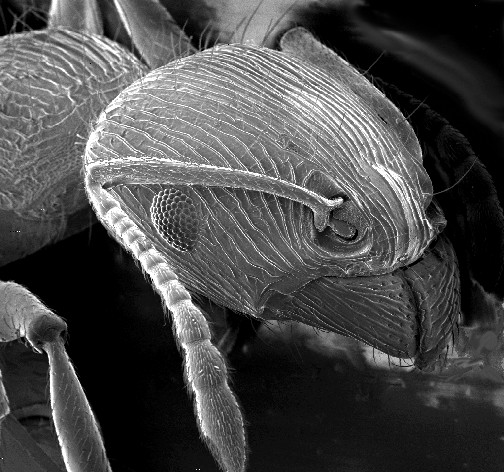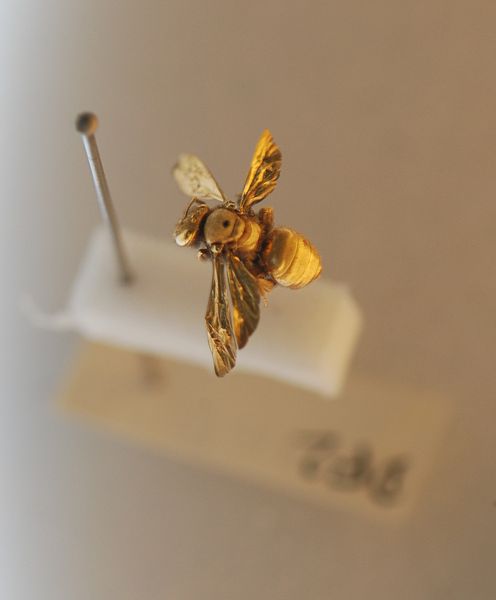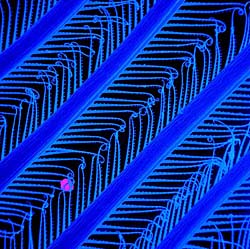Electron microscope
Overview
An electron microscope is a type of microscope that uses electrons as a way to illuminate and create an image of a specimen. It has much higher magnification and resolving power than a light microscope, with magnifications up to about two million times, compared to about two thousand that can be achieved with visible light.
This high magnification allows electron microscopes to see smaller objects and greater detail in these objects. Unlike a light microscope, which uses glass lenses to focus light, the electron microscope uses electrostatic and electromagnetic lenses to control the illumination and imaging of the specimen.
History

The first electron microscope prototype was built in 1931 by the German engineers Ernst Ruska and Max Knoll.[1] It was based on the ideas and discoveries of French physicist Louis de Broglie. Although it was primitive and not fit for practical use, the instrument was still capable of magnifying objects by four hundred times.
Reinhold Rudenberg, the research director of Siemens, had patented the electron microscope in 1931, although Siemens was doing no research on electron microscopes at that time. In 1937 Siemens began funding Ruska and Bodo von Borries to develop an electron microscope. Siemens also employed Ruska's brother Helmut to work on applications, particularly with biological specimens.[2][3]
In the same decade of 1930s Manfred von Ardenne pioneered the scanning electron microscope and his universal electron microscope.[4]
Siemens produced the first commercial TEM in 1939, but the first practical electron microscope had been built at the University of Toronto in 1938, by Eli Franklin Burton and students Cecil Hall, James Hillier and Albert Prebus.[5]
Although modern electron microscopes can magnify objects up to two million times, they are still based upon Ruska's prototype. The electron microscope is an integral part of many laboratories. Researchers use it to examine biological materials (such as microorganisms and cells), a variety of large molecules, medical biopsy samples, metals and crystalline structures, and the characteristics of various surfaces. The electron microscope is also used extensively for inspection, quality assurance and failure analysis applications in industry, including, in particular, semiconductor device fabrication.
Electron microscope manufacturers
Major manufacturers include:
- Delong Group
- FEI Company – USA (merged with Philips Electron Optics)
- FOCUS GmbH – Germany
- Hitachi – Japan
- JEOL Ltd. – Japan (Japan Electro Optics Laboratory)
- TESCAN – EU
- Carl Zeiss NTS GmbH
Types
Transmission Electron Microscope (TEM)
The original form of electron microscopy, Transmission electron microscopy (TEM) involves a high voltage electron beam emitted by a cathode, usually a tungsten filament and focused by electrostatic and electromagnetic lenses. The electron beam that has been transmitted through a specimen that is in part transparent to electrons carries information about the inner structure of the specimen in the electron beam that reaches the imaging system of the microscope. The spatial variation in this information (the "image") is then magnified by a series of electromagnetic lenses until it is recorded by hitting a fluorescent screen, photographic plate, or light sensitive sensor such as a CCD (charge-coupled device) camera. The image detected by the CCD may be displayed in real time on a monitor or computer.
Resolution of the TEM is limited primarily by spherical aberration, but a new generation of aberration correctors have been able to partially overcome spherical aberration to increase resolution. Software correction of spherical aberration for the High Resolution TEM HRTEM has allowed the production of images with sufficient resolution to show carbon atoms in diamond separated by only 0.89 ångström (89 picometers) and atoms in silicon at 0.78 ångström (78 picometers)[6][7] at magnifications of 50 million times.[8] The ability to determine the positions of atoms within materials has made the HRTEM an important tool for nano-technologies research and development.
Scanning Electron Microscope (SEM)
Unlike the TEM, where electrons of the high voltage beam form the image of the specimen, the Scanning Electron Microscope (SEM)[9] produces images by detecting low energy secondary electrons which are emitted from the surface of the specimen due to excitation by the primary electron beam. In the SEM, the electron beam is rastered across the sample, with detectors building up an image by mapping the detected signals with beam position.
Generally, the TEM resolution is about an order of magnitude greater than the SEM resolution, however, because the SEM image relies on surface processes rather than transmission it is able to image bulk samples and has a much greater depth of view, and so can produce images that are a good representation of the 3D structure of the sample.
Reflection Electron Microscope (REM)
In addition there is a Reflection Electron Microscope (REM). Like TEM, this technique involves electron beams incident on a surface, but instead of using the transmission (TEM) or secondary electrons (SEM), the reflected beam is detected. This technique is typically coupled with Reflection High Energy Electron Diffraction and Reflection high-energy loss spectrum (RHELS). Another variation is Spin-Polarized Low-Energy Electron Microscopy (SPLEEM), which is used for looking at the microstructure of magnetic domains.[10]
Scanning Transmission Electron Microscope (STEM)
The STEM combines the high resolution of the TEM with the beam rastering functions of the SEM, allowing a range of analytical techniques to be used that are not possible with conventional TEM.
Sample Preparation

Materials to be viewed under an electron microscope may require processing to produce a suitable sample. The technique required varies depending on the specimen and the analysis required:
- Cryofixation – freezing a specimen so rapidly, to liquid nitrogen or even liquid helium temperatures, that the water forms vitreous (non-crystalline) ice. This preserves the specimen in a snapshot of its solution state. An entire field called cryo-electron microscopy has branched from this technique. With the development of cryo-electron microscopy of vitreous sections (CEMOVIS), it is now possible to observe virtually any biological specimen close to its native state.
- Dehydration – replacing water with organic solvents such as ethanol or acetone.
- Embedding – infiltration of the tissue with a resin such as araldite or epoxy for sectioning. After this embedding process begins, the specimen must be polished to a mirror-like finish using ultra-fine abrasives. The polishing process must be done accordingly, or it may lead to scratches imposing on the image quality.
- Sectioning – produces thin slices of specimen, semitransparent to electrons. These can be cut on an ultramicrotome with a diamond knife to produce very thin slices. Glass knives are also used because they can be made in the lab and are much cheaper.
- Staining – uses heavy metals such as lead, uranium or tungsten to scatter imaging electrons and thus give contrast between different structures, since many (especially biological) materials are nearly "transparent" to electrons (weak phase objects). In biology, specimens are usually stained "en bloc" before embedding and also later stained directly after sectioning by brief exposure to aqueous (or alcoholic) solutions of the heavy metal stains.
- Freeze-fracture or freeze-etch – a preparation method particularly useful for examining lipid membranes and their incorporated proteins in "face on" view. The fresh tissue or cell suspension is frozen rapidly (cryofixed), then fractured by simply breaking or by using a microtome while maintained at liquid nitrogen temperature. The cold fractured surface (sometimes "etched" by increasing the temperature to about -100°C for several minutes to let some ice sublime) is then shadowed with evaporated platinum or gold at an average angle of 45° in a high vacuum evaporator. A second coat of carbon, evaporated perpendicular to the average surface plane is often performed to improve stability of the replica coating. The specimen is returned to room temperature and pressure, then the extremely fragile "pre-shadowed" metal replica of the fracture surface is released from the underlying biological material by careful chemical digestion with acids, hypochlorite solution or SDS detergent. The still-floating replica is thoroughly washed from residual chemicals, carefully fished up on EM grids, dried then viewed in the TEM.
- Ion Beam Milling – thins samples until they are transparent to electrons by firing ions (typically argon) at the surface from an angle and sputtering material from the surface. A subclass of this is Focused ion beam milling, where gallium ions are used to produce an electron transparent membrane in a specific region of the sample, for example through a device within a microprocessor. Ion beam milling may also be used for cross-section polishing prior to SEM analysis of materials that are difficult to prepare using mechanical polishing.
- Conductive Coating – An ultrathin coating of electrically-conducting material, deposited either by high vacuum evaporation or by low vacuum sputter coating of the sample. This is done to prevent the accumulation of static electric fields at the specimen due to the electron irradiation required during imaging. Such coatings include gold, gold/palladium, platinum, tungsten, graphite etc. and are especially important for the study of specimens with the scanning electron microscope. Another reason for coating, even when there is more than enough conductivity, is to improve contrast, a situation more common with the operation of a FESEM (field emission SEM). When an osmium coater is used, a layer far thinner than would be possible with any of the previously mentioned sputtered coatings is possible.[1]
Disadvantages

Electron microscopes are expensive to buy and maintain. They are dynamic rather than static in their operation: requiring extremely stable high-voltage supplies, extremely stable currents to each electromagnetic coil/lens, continuously-pumped high-/ultra-high-vacuum systems, and a cooling water supply circulation through the lenses and pumps. As they are very sensitive to vibration and external magnetic fields, microscopes aimed at achieving high resolutions must be housed in buildings (sometimes underground) with special services. Newer generations of TEM operating at lower voltages (around 5 kV) do not have stringent voltage supply, lens coil current, cooling water or vibration isolation requirements and as such are much less expensive to buy and far easier to install and maintain.
The samples have to be viewed in vacuum, as the molecules that make up air would scatter the electrons. Recent advances have allowed hydrated samples to be imaged using an environmental scanning electron microscope
Scanning electron microscopes usually image conductive or semi-conductive materials best. Non-conductive materials can be imaged by an environmental scanning electron microscope. A common preparation technique is to coat the sample with a several-nanometer layer of conductive material, such as gold, from a sputtering machine; however this process has the potential to disturb delicate samples.
The samples have to be prepared in many ways to give proper detail, which may result in artifacts purely the result of treatment. This gives the problem of distinguishing artifacts from material, particularly in biological samples. Scientists maintain that the results from various preparation techniques have been compared, and as there is no reason that they should all produce similar artifacts, it is therefore reasonable to believe that electron microscopy features correlate with living cells. In addition, higher-resolution work has been directly compared to results from X-ray crystallography, providing independent confirmation of the validity of this technique. Recent work performed on unfixated, vitrified specimens has also been performed, further confirming the validity of this technique.
Electron Microscopy Application areas
Semiconductor & Data Storage
Biology & Life Sciences
Research
- Materials Qualification
- Materials and Sample Preparation
- Nanoprototyping
- Nanometrology
- Device Testing and Characterization
Industry
See also
References
- ↑ Ernst Ruska Nobel Prize autobiography
- ↑ Ernst Ruska (1986). "Ernst Ruska Autobiography". Nobel Foundation. Retrieved 2007-02-06.
- ↑ DH Kruger, P Schneck and HR Gelderblom (13). "Helmut Ruska and the visualisation of viruses". The Lancet. 355 (9216): 1713–1717. doi:10.1016/S0140-6736(00)02250-9. Unknown parameter
|month=ignored (help); Check date values in:|date=, |year= / |date= mismatch(help) - ↑ M von Ardenne and D Beischer (1940). "Untersuchung von metalloxud-rauchen mit dem universal-elektronenmikroskop". Zeitschrift Electrochemie (in German). 46: 270–277.
- ↑ MIT biography of Hillier
- ↑ OÅM: World-Record Resolution at 0.78 Å, (May 18, 2001) Berkeley Lab Currents.
- ↑ P. D. Nellist, M. F. Chisholm, N. Dellby, O. L. Krivanek, M. F. Murfitt, Z. S. Szilagyi, A. R. Lupini, A. Borisevich, W. H. Sides, Jr., S. J. Pennycook (17). "Direct Sub-Angstrom Imaging of a Crystal Lattice". Science. 305 (5691): 1741. doi:10.1126/science.1100965. Unknown parameter
|month=ignored (help); Check date values in:|date=, |year= / |date= mismatch(help) - ↑ The Scale of Things, DOE Office of Basic Energy Sciences (BES).
- ↑ SCANNING ELECTRON MICROSCOPY 1928 - 1965
- ↑ http://ncem.lbl.gov/frames/spleem.htm
External links
- Electron Microscopy Supplies, Accessories, and Sample Preparation Equipment – SPI Supplies
- Electron Microscopy Supplies – Ladd Research
- Environmental Scanning Electron Microscope (ESEM)
- X-ray element analysis in electron microscope – Information portal with X-ray microanalysis and EDX contents
- BEEM Products for Microscopy – BEEM, Inc.
- John H.L. Watson: Very early Electron Microscopy in the Department of Physics, the University of Toronto – A personal recollection
- Rubin Borasky Electron Microscopy Collection, 1930-1988 Archives Center, National Museum of American History, Smithsonian Institution.
ca:Microscopi electrònic cs:Elektronový mikroskop da:Elektronmikroskop de:Elektronenmikroskop eo:Elektrona mikroskopo fa:میکروسکوپ الکترونی gl:Microscopio electrónico hr:Elektronski mikroskop id:Mikroskop elektron it:microscopio elettronico he:מיקרוסקופ אלקטרוני ms:Mikroskop elektron nl:Elektronenmicroscopie mk:Електронски микроскоп no:Elektronmikroskop simple:Electron microscope fi:Elektronimikroskooppi sv:Elektronmikroskop ta:இலத்திரன் நுண்நோக்கி Template:Jb1